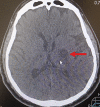Stereotactic Staged Asymmetric Bilateral Radiofrequency Lesioning for Parkinson's Disease
- PMID: 37844550
- PMCID: PMC10711767
- DOI: 10.1159/000534084
Stereotactic Staged Asymmetric Bilateral Radiofrequency Lesioning for Parkinson's Disease
Abstract
Introduction: Parkinson's disease (PD) is one of the most common neurodegenerative progressive disorders. Despite the dominance of neurostimulation technology, stereotactic lesioning operations play a significant role in the treatment of PD. The aim of the study was to evaluate the effectiveness and safety of staged bilateral asymmetric radiofrequency (RF) stereotactic lesioning in a highly selected group of PD patients.
Material and methods: A retrospective review of 418 consecutive patients undergoing stereotactic ablation for advanced PD at our institution revealed 28 patients who underwent staged asymmetric bilateral ablation. In this subset, after initial RF thalamotomy, contralateral pallidotomy was performed in 16 (57.1%) patients (group Vim-GPi), and contralateral lesion of the subthalamic nucleus (STN) was performed in 12 (32.9%) patients (group Vim-STN). The mean duration of disease before the first surgery was 9.9 ± 0.8 years. The mean interval between the two operations was 3.5 ± 0.4 years (range, 1-10 years); in the Vim-GPi group, it was 3.1 ± 0.4 years; and in the Vim-STN group, it was 4.3 ± 0.1 years. After the second operation, the long-term follow-up lasted from 1 to 8 years (mean 4.8 ± 0.5 years). All patients were evaluated 1 year after the second operation.
Results: One year after staged bilateral lesioning, the mean tremor score improved from baseline, prior to the first operation, from 19.8 to 3.8 (improvement of 81%), the overall mean rigidity score improved from 11.0 to 3.7 (improvement of 66%), and hypokinesia improved from 14.8 to 8.9 (improvement of 40%). One year after staged bilateral lesioning, the total UPDRS score improved in the Vim-GPi group by 47% in the OFF and 45.9% in the ON states. In the Vim-STN group, the total UPDRS score improved from baseline, prior to the first operation, by 44.8% in the OFF and 51.6% in the ON states. Overall, levodopa dose was reduced by 43.4%. Neurological complications were observed in 4 (14.3%) cases; among them, 1 (3.6%) patient had permanent events related to local ischemia after pallidotomy.
Conclusion: Staged asymmetric bilateral stereotactic RF lesioning can be a safe and effective method in highly selected patients with advanced PD, particularly where deep brain stimulation is not available or desirable. Careful identification and selection of patients for ablative surgery allow achieving optimal results in the treatment of PD with bilateral symptoms.
Keywords: Bilateral lesioning; Pallidotomy; Parkinson’s disease; Subthalamotomy; Thalamotomy.
© 2023 The Author(s). Published by S. Karger AG, Basel.
Conflict of interest statement
The author has no conflicts of interest to declare.
Figures





Similar articles
-
Unilateral subthalamotomy in the treatment of Parkinson's disease.Brain. 2003 May;126(Pt 5):1136-45. doi: 10.1093/brain/awg111. Brain. 2003. PMID: 12690053
-
Unilateral subthalamic nucleus lesioning: a safe and effective treatment for Parkinson's disease.Arq Neuropsiquiatr. 2002 Dec;60(4):935-48. doi: 10.1590/s0004-282x2002000600010. Epub 2003 Jan 15. Arq Neuropsiquiatr. 2002. PMID: 12563384
-
Subthalamic nucleus stimulation in tremor dominant parkinsonian patients with previous thalamic surgery.J Neurol Neurosurg Psychiatry. 2005 Feb;76(2):246-8. doi: 10.1136/jnnp.2003.022707. J Neurol Neurosurg Psychiatry. 2005. PMID: 15654041 Free PMC article. Clinical Trial.
-
Congress of Neurological Surgeons Systematic Review and Evidence-Based Guideline on Subthalamic Nucleus and Globus Pallidus Internus Deep Brain Stimulation for the Treatment of Patients With Parkinson's Disease: Executive Summary.Neurosurgery. 2018 Jun 1;82(6):753-756. doi: 10.1093/neuros/nyy037. Neurosurgery. 2018. PMID: 29538685 Free PMC article.
-
Surgical Treatment of Parkinson's Disease: Devices and Lesion Approaches.Neurotherapeutics. 2020 Oct;17(4):1525-1538. doi: 10.1007/s13311-020-00939-x. Epub 2020 Oct 28. Neurotherapeutics. 2020. PMID: 33118132 Free PMC article. Review.
Cited by
-
Unilateral Stereotactic Radiofrequency Lesioning as a Surgical Treatment Option for Meige Syndrome.Cureus. 2024 Aug 17;16(8):e67064. doi: 10.7759/cureus.67064. eCollection 2024 Aug. Cureus. 2024. PMID: 39290919 Free PMC article.
-
Bilateral Lesions in Parkinson's Disease: Gaps and Controversies.Mov Disord. 2025 Feb;40(2):231-240. doi: 10.1002/mds.30090. Epub 2024 Dec 27. Mov Disord. 2025. PMID: 39726415 Free PMC article. Review.
-
Radiofrequency Ablation in the MRI Era: Back to Our Roots - Commentary on Kostiuk: "Stereotactic Staged Asymmetric Bilateral Radiofrequency Lesioning for Parkinson's Disease".Stereotact Funct Neurosurg. 2024;102(1):55-57. doi: 10.1159/000534796. Epub 2023 Dec 1. Stereotact Funct Neurosurg. 2024. PMID: 38043526 Free PMC article. No abstract available.
-
Novel perspective of therapeutic modules to overcome motor and nonmotor symptoms in Parkinson's disease.AIMS Neurosci. 2024 Sep 6;11(3):312-340. doi: 10.3934/Neuroscience.2024020. eCollection 2024. AIMS Neurosci. 2024. PMID: 39431269 Free PMC article. Review.
References
MeSH terms
Substances
LinkOut - more resources
Full Text Sources
Medical
Miscellaneous

